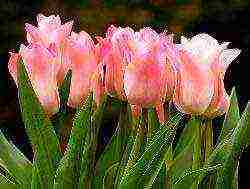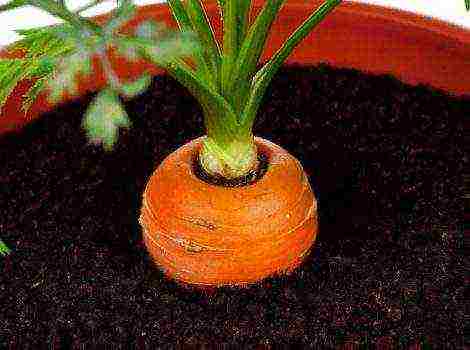Content
Often, the owners of summer cottages want to turn every square meter into a useful one. For example, a cellar or basement can be transformed from a storage place for a crop to a place to grow it. Today we will tell you how to grow oyster mushrooms in the basement, as well as mushrooms.
What should be the basement
When deciding how to grow champignons in the basement, first of all, you should think about providing the necessary conditions. As already mentioned, cultivation in a cellar or basement will be optimal for mushrooms. Some people try to grow oyster mushrooms and mushrooms in a house or apartment, but it is almost impossible to create comfortable conditions for the growth of mushrooms in a living space. Some mushroom pickers resort to planting in a brick garage, which can be a good substitute for a cellar.
Thus, growing mushrooms in the basement is currently the most economical and least labor-intensive of the above options. However, to get a rich harvest, you will have to carefully study the technology of cultivation of oyster mushrooms and mushrooms.
Necessary lighting
Growing champignons in the basement does not require any sunlight as mushrooms grow best in complete darkness.
Proper ventilation
Mushrooms in the basement require the correct microclimate, which is ensured by constantly maintaining the level of ventilation, temperature, and so on in the same indicators.
The ventilation system should not be open windows and doors that create drafts. Supply ventilation may also be insufficient to provide the culture with a constant supply of oxygen. The best option is a forced ventilation system, when metal grates and fine-mesh nets are installed on the air outlets, protecting the plants from the invasion of rodents and insects.
Humidity and temperature
When growing mushrooms and oyster mushrooms, it is important to ensure a constant room temperature and a high level of humidity. Champignons and oyster mushrooms in the basement are grown at a temperature of 12 to 27 ° C and a humidity of at least 65%.
To maintain the temperature in the basement, a thermometer is installed, as well as a heating system (warm floor, heaters). Since all artificial sources of heat dry the air very much, you will have to maintain the humidity manually, having stocked up with polyethylene and a sprinkler.
Zoning
The cultivation of champignons in the basement can be carried out in the most modest conditions in terms of area. To save usable space and plant as much planting material as possible, the construction of racks is recommended. The materials used are metal, plastic and wood. However, it is better to choose stainless steel as a metal, and treat wood with impregnations against rotting, which is inevitable in conditions of high humidity.
Sometimes bags, wooden boxes, wood chunks are used as a device for mycelium. All these options are possible to use, however, they are more troublesome.
Disinfection
In preparation for growing mushrooms in the basement, the disinfection stage is perhaps the most important. Insects and fungal diseases are the enemies of the crop. The main source of all problems is high humidity.Therefore, if the walls are earthen or wooden, the development of the fungus is inevitable.
In this case, it is important to ensure the maximum remoteness of the room from the ground and natural wood. For this, the floors are poured with concrete, and the walls are laid out of bricks, plastered and treated with an anti-fungal solution. The ceiling is whitewashed with a solution of lime and copper sulfate. The entire room is disinfected (for example, with formalin, fumigated with a sulfuric gas) before each new planting. All elements of the arrangement are also carefully treated with antiseptics, and dishes and small parts are boiled.
Cultivars for cultivation
Not every farmer is ready to grow labor-intensive varieties of mushrooms. Oyster mushrooms and mushrooms are chosen as the best option for cultivation at home. However, among them there are different varieties.
Growing oyster mushrooms provides an opportunity to choose among many "home" species. These include Common Oyster, Oyster Oyster, Horned, Late and White Elf. There are other hybrids, but they are not much different from each other. Oyster mushrooms are very undemanding to soil and fertilizers, they give large yields and are resistant to infectious diseases.
Among the champignons, there are a number of hybrids that are offered by large nurseries and mushroom farms. They differ in size, shape and color, but are similar in taste and vegetative characteristics.
Substrate preparation and planting
There are two ways to prepare the substrate - buy ready-made in the store or do it yourself. Prepare the substrate a month before planting the mycelium, and use as ingredients:
- horse manure (if not, then cow or chicken droppings);
- straw;
- urea;
- superphosphates and fertilizers containing ammonium;
- a piece of chalk;
- gypsum or alabaster.
Horse manure and straw are preliminarily disinfected from parasites. Then the straw is soaked in a warm solution of water and ammonium nitrate for 24 hours. After the expiration of time, the straw is shifted with manure, moistened with ordinary warm water and left for several days, after which the composition is thoroughly mixed. Then gradually, at intervals of 3-4 days, the remaining ingredients are added, which are also mixed each time. When the temperature of the mixture has dropped to 25-23 ° C, the compost is ready for use.
The mycelium is bought in special stores, where it is grown under sterile conditions.
There are two types of mycelium - grain and compost. Make sure there are no green or black spots on it at the time of purchase.
After laying the substrate, you can start growing mycelium. For this, the compost mycelium is placed in pits up to 5 cm deep, located at a distance of 15–20 cm from each other. The packed mycelium is filled up and watered. The grain mycelium is simply scattered over the surface of the substrate.
Care and cultivation
During the development of mushroom filaments, the optimum temperature is 22–27 ° C, after their appearance it drops to 12–15 ° C. The first mushroom filaments appear 2 weeks after planting, after which the planting surface is covered with a mixture of peat, leaf earth and limestone (5: 4: 1).
Mushrooms love moisture, for which the first 2 weeks they are sprayed every 3-4 days. For this, the surface of the substrate is covered with polyethylene and sprayed with warm water. Further, it is better to suspend frequent hydration so as not to cause rotting of the mycelium.
Harvesting
The first wave of harvest awaits you 12-16 weeks after planting, and regular fruiting will last for the next 10-16 weeks. After each ripening, the mushrooms are carefully twisted, and a small layer of earth is laid in their place. After each collection, the substrate is watered with a solution of water and superphosphates.
Video "Technology of growing mushrooms"
This video will show you how to grow mushrooms at home.

Growing mushrooms in a cellar
How to grow mushrooms in the basement is of interest to many.Such a business can be a good option for additional income.
At the same time, much effort is not required from the business owner, but there are some features of the cultivation technology that must be observed. How to grow mushrooms in the basement with your own hands is invited to learn from this article.
Features of growing mushrooms in the basement
The advantages of a business idea for growing oyster mushrooms, mushrooms and honey agarics in the basement are:
- Mushrooms do not need constant attention.
- When growing them, the owner will not be busy all day.
- The process does not require special knowledge and skills.
- The materials used in this case, most often, are quite simple, and more complex ones can be purchased ready-made.
In practice, when growing mushrooms to create a business, difficulties arise:
- It is difficult to find a sales market. In this case, for the sale of large volumes of products, it is required to conclude contracts with restaurants, chain stores or canneries, which is a rather complicated matter. The same rabbits will be more readily sold (read Rabbits in the cellar: how to keep them properly).
- It is not so easy to maintain a consistently high yield: diseases, fungal parasites and other risks can arise here.
Tip: Growing mushrooms should, first of all, be considered as an opportunity to generate additional income.
The technology of growing mushrooms in the basement
The most popular is oyster mushroom cultivation in the basement. This is due to the fact that the cost of preparing the substrate and the process itself is much less than champignons and honey agarics.
Oyster mushroom can be obtained indoors all year round, or outdoors during the summer season.
Growing mushrooms can be done in:
- Greenhouse.
- Basement.
- The room.
- Barn.
Read also Greenhouse in the basement of the house: a business idea
The main condition is cleanliness and dryness of the room. Before laying the mushrooms, the basement walls and the floor must be disinfected with a solution of bleach and then well ventilated.
The process will require two rooms:
- For the germination of mycelium.
- For the growth of mushrooms.
After preparing the place for growing oyster mushrooms, the instruction further suggests:
- Prepare the substrate. This can be done in several ways:
- hydroderma or hot water treatment;
- xerothermia or steam treatment of a dry substrate;
- pasteurization or steam treatment of a moist substrate.
In any case, the main thing is to water the substrate for oyster mushrooms with moisture and create air permeability to it, which is necessary to create comfortable conditions during the development of mycelium, but at the same time not to damage it by the defeat of moldy fungi that are contained in the substrate. The material for the substrate blocks can be straw, dry corn stalks, hulls from sunflower seeds or buckwheat.
Hardwood shavings are an excellent material, but novice mushroom pickers should not use them during the trial period. For oyster mushrooms, the substrate should be free of rot and mold. Overmoistening should not be allowed, especially when processing it with hot water.
Tip: If you still get excess moisture, you can leave it for several days just to drain.
Then the raw material is crushed to small fractions, to retain moisture by the substrate, and after heat treatment, it is checked for excess moisture, for this the mass is compressed by hand. A material with good moisture will spring, but water will not protrude outside. Such a substrate is ready for laying the mycelium:
- Lay the substrate in layers in plastic bags with holes from 1.5 to 2 centimeters every 10 centimeters. The mycelium of the fungus is laid between the layers, as shown in the photo.
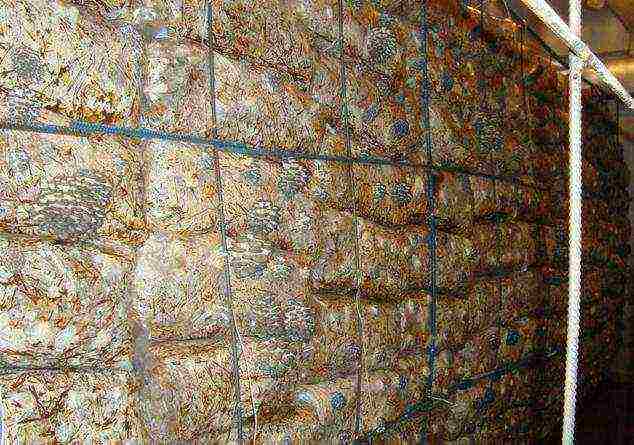
Unfolding the substrate in the basement
When deciding to purchase oyster mushroom mycelium, it is important to follow some simple rules:
- It is better to buy them from trusted suppliers.
- First you need to take a trial batch.
- It is necessary to inquire about the variety and strain of the mushroom, which should be reflected on the label on the package.
- What is the percentage and rate of grain fouling.
- How resistant they are to mold.
- Shelf life.
- It is necessary to check its temperature inside, whether it has overheated upon delivery. The optimum temperature is + 20 ° C.
- The mycelium should be bright orange in color with a small admixture of yellow exudate, without green or black spots with the smell of ammonia.
- It is necessary to store the seed mycelium in the refrigerator at a temperature not exceeding 4 ° C. It is not allowed to place it in the freezer.
- The preservation of such mycelium should not exceed three months, and the substrate should not exceed nine months.
Tip: After purchasing the bags, you need to let them cool down, and only then fold, leaving free air access. When storing mycelium at home, the bags should not lie with each other, which can reduce their shelf life.
- Before the laying, the mycelium is crushed, without opening the bags, which equalizes its temperature and the substrate, and makes it possible to avoid thermal shock of the mycelium.
- When opening the package, it is very important to observe sterile conditions: it must be treated with a disinfectant solution.
Tip: The room where oyster mushrooms are grown should be separated from the room for planting mycelium, which will prevent mycelium infestation. All operations when laying the mycelium should be carried out under sterile conditions and with gloves.
- The bags are placed in a dark, closed room with an air humidity of about 95%, and a temperature of 22 to 25 degrees for 20 to 30 days.
- Move bags to a cooler area.
- The room where the oyster mushroom grows, it is necessary to organize special ventilation to remove carbon dioxide, and humidification.
Tip: Avoiding complex technology, you can use a simple method for ventilation: put several buckets of water in the room, and use a fan to maintain air circulation.
Indoors, the temperature should be between +12 and +18 degrees, with a humidity of 95%. You need to light it continuously 12 hours a day, for this you can install fluorescent lamps.
Advice: When working indoors, you need to follow safety precautions: wear a gauze bandage, and preferably a respirator. This is due to the fact that oyster mushroom spores can cause allergies and a very severe cough. In case of a large number of fungi, the use of respiratory protection is imperative!
- After collecting two crops of oyster mushroom from one bag, its contents are replaced with a new one.
- The optimal collection rate from 10 kg of substrate is up to 3 kg of mushrooms, while changing the substrate per year can be up to five times or once every three months.
- From a square meter of "plantation" you can collect from 80 to 100 kg of mushrooms per year.
When growing honey agarics, the technology will be slightly different
for them, the substrate is prepared the same as for oyster mushrooms, but pasteurized with a boiling nutrient solution.
For this:
- Fruit or berry jam, corn flour or starch are added to the water.
- Excess water is drained away.
- The substrate and mycelium are placed in plastic bags or glass jars of three to five liters.
The cultivation of champignons has its own characteristics:
When growing them, ordinary sawdust is no longer enough, it will be necessary to prepare compost. You can buy it ready-made from agricultural enterprises, or prepare it yourself, but for beginners it will be quite difficult.
How to grow mushrooms in the basement is described in detail and shown in the video. Good luck!
If you have a basement in a private house, you can use the cellar to store products from your backyard, or you can grow it there. It sounds incredible, but there are many types of vegetables and plants grown in basements.
A well-equipped cellar is suitable for growing mushrooms, as well as herbs such as parsley or dill, truffles, growing oyster mushrooms, porcini mushrooms, strawberries and strawberries, and much more. If desired, such production can be perceived as a business with considerable income.
The most common, in addition to growing oyster mushrooms in the basement, are champignons. Consider ways to grow champignons in your basement.
How to grow mushrooms in your basement
The technology for growing mushrooms in the basement of a house is one of the common technologies for growing mushrooms underground and does not require complex preparatory work.
All over the world, underground mushroom growing is perceived as the norm, and in our conditions such a method of obtaining mushrooms is also quite possible. Special requirements, except for good ventilation, are not required, since the basement has an optimal microclimate and a slight change in humidity and temperature indicators.
Usually, an ordinary cellar is adapted for growing champignons, it is only important that its walls are concrete. The floor is concreted or poured with a cement screed. To avoid the appearance of mold and fungal infections, the walls and ceiling are whitewashed with lime with the addition of copper sulfate.
Ventilation holes or pipe outlets are mounted with a special fine-grained mesh so that small pests do not penetrate into the room during the warm season.
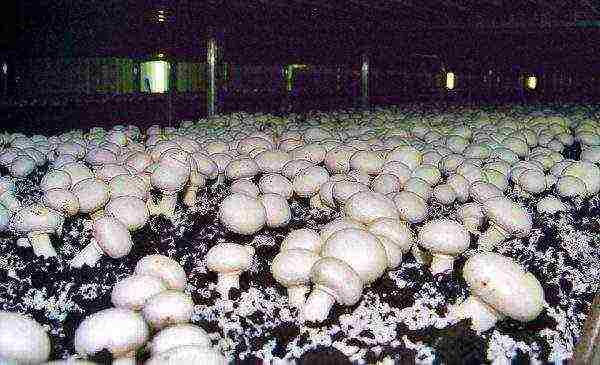
Features of home cultivation of champignons
Growing champignons is not a difficult job, but it requires certain knowledge and proper skill in the technologies used.
There are a number of factors on which the harvest of mushrooms depends - this is the correct compost, timely and sufficient watering of the mycelium, maintaining an optimal microclimate, fighting pests and various kinds of diseases.
If all these conditions are met, growing mushrooms in the basement is quite laborious.
Preparing a room for growing mushrooms
The cellar must be isolated from drafts that interfere with maintaining a certain temperature and humidity of the underground. Before growing champignons, it is important to equip proper ventilation, since carbon dioxide is replaced by oxygen at the chemical level.
Carbon dioxide is generated by the decomposition of the compost substrate. As a rule, the supply and exhaust air exchange circuit is equipped. Its arrangement in the basement requires special attention.
The cellar room is pre-disinfected, since fungi are vulnerable to a variety of diseases and infections. As a rule, I use sulfur fumigation, whitewashing of surfaces with lime with vitriol, or spraying with a 4% formalin solution.
The soil in the basement is also treated from possible infection, and the bottom of the surface, where the compost will be, is lined with some material on which the breeding itself in boxes will take place.
In front of the entrance to the basement, a disinfector box is installed, filled with sawdust with a disinfecting impregnation. After all the work, the room is ventilated and the main work begins.
Substrate preparation
When growing mushrooms at home, preparing the substrate is one of the most time consuming steps. There are quite a few open source videos out there, as it is a rather complicated process. It is necessary to follow exactly the instructions for its composition in order to get a good harvest.
A quarter of compost is made of rye or winter wheat straw, and the rest is diluted with horse manure. For 1 centner of straw, 2 kg of urea and superphosphate, 8 kg of gypsum and 5 kg of chalk are taken. After that, horse manure is introduced and approximately 300 kg of substrate are obtained.
This amount is sufficient for 3 square meters of cultivation. If it is impossible to get horse, poultry or chicken droppings are used. But this will negatively affect the yield of mushrooms, which are very whimsical to the basis for growing.
The substrate is made outdoors under a canopy. The straw must be soaked in water for a day and stacked under a canopy along with manure. It is recommended to use urea and superphosphate for impregnating the layers. Then the whole mass is thoroughly mixed, with the addition of other components to the substrate.
Immediately after mixing, the fermentation process begins, and after three days the temperature in such a stack rises to 70 degrees above zero. The height of such a mass is about a meter, as well as the length. The length is about 1.2 m. After three weeks the compost is ready.
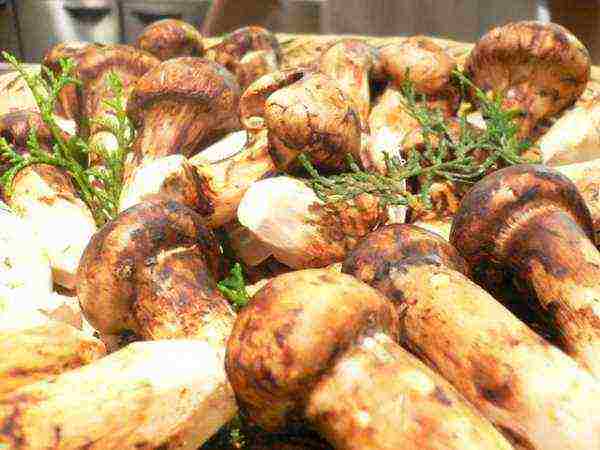
The technology of growing champignons in the basement
To obtain a plentiful and healthy harvest, it is necessary to use only sterile mycelium as the main material. They are grown in special laboratories, and for 1 square meter of substrate it is necessary to take 0.5 kg of compost mycelium or 0.4 kg of grain.
Planting mycelium
Immediately before planting, it is required to check the substrate again for springiness. For this, a handful of mycelium is taken and lowered to a planting depth of 5 cm. The holes are positioned 20 cm wide in a checkerboard pattern relative to each other. The grain mycelium simply crumbles over the surface.
Mycelium care
During the entire rooting period, it is necessary to maintain the temperature and humidity (70-95%) in the cellar. For this, the box with the mycelium is covered with newspaper and constantly sprayed with a spray bottle. The substrate temperature should be at least 27 degrees above zero.
After a week, you will notice an increase in the mycelium. At this stage, the surface is covered with a layer of 3-4 cm of soil. This will bring the temperature down to 12-17 degrees. At the same time, the surface is also constantly moistened and drafts are not allowed.
Harvesting
After 3-4 months, the first crop is ready for harvest. Collect only those mushrooms whose caps have a stretched white film under the surface that connects the stem of the champignon with the edges of the cap. Mushrooms with a brown plate are discarded and not eaten in any way.
There is a certain nuance when collecting champignons - they are twisted out of the mycelium, and not cut off. The fruiting period is about two weeks, during which up to 8 waves of the crop are harvested. The yield is about 12 kg per square meter. Approximately 70% of the total harvest falls on the first three waves.
Champignon disease prevention and pest control
By fulfilling the mandatory requirements for planting, caring for the mycelium, diseases inherent in mushrooms can be avoided. But it is better to play it safe and carry out treatment to prevent infection.
At the very initial stage, one of the preventive measures was the disinfection of the basement or cellar, equipment and tools - everything that affects the growth and yield of mushrooms.
When composting, it is necessary to exclude the ingress and interaction of compost with the soil. The compost is prepared on a paved area or asphalt. During the growth of mycelium, the indicators of aeration, humidity and temperature should be monitored. Overheating of the compost is unacceptable.
The material to be coated is an excellent breeding ground for fungus or mold, the multiplication of various microorganisms. Must be thoroughly steam treated.
All work with the mycelium begins in the same sequence as when planting. It is necessary to clean the area around the cultivated mushrooms - mushroom residues, manure, pieces of substrate mixture, etc.
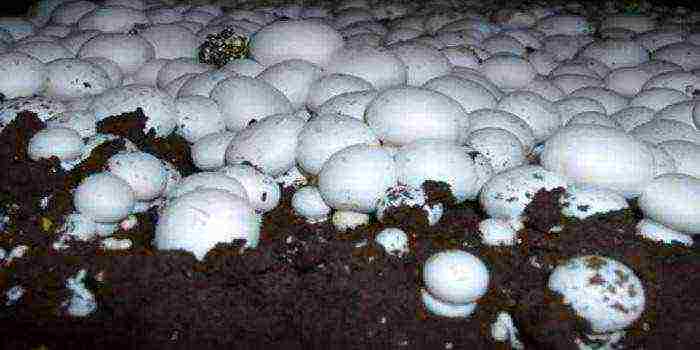
If the disease has nevertheless penetrated the slender rows of mushrooms, then it must be localized and cleaned up as soon as possible. The most common occurrence is brown spotting - brown and cinnamon unpleasant spots appear on the snow-white caps of mushrooms. This spreads very quickly, so it is very important to rush into processing.
Another type of fungal disease is their mummification - they become covered with a gray coating, dry out and have an unpleasant odor.
The source of infection can only be covering material, compost substrate or remnants of previously harvested mushrooms. As soon as a container is hit by something, it should be immediately isolated from others.
Halogen has proven itself well in the fight against bacteria in the form of various solutions. The rows of mycelium are spilled with its 1% solution.Growing mushrooms in the basement is not limited to champignons, it is quite possible to grow porcini mushrooms in the cellar on your own.
How to grow porcini mushrooms in the basement
Just like champignons, porcini mushrooms grow well in an artificial environment. For their abundant harvest, an intensive reproduction technology is used.
Room preparation
The preparation of the cellar for the cultivation of porcini mushrooms is very similar to the scheme of preliminary work on the reproduction of the mushroom mycelium.
There are slight differences in temperature and humidity indicators. Such mushrooms love temperatures around 12 degrees Celsius and humidity around 80%. He is also picky about oxygen, so the room must be thoroughly ventilated.
The incubation period of the mushroom does not require light, but as soon as the fruits appear, provide them with sufficient lighting for at least 5 hours a day. There are no requirements for the light source - it can be both artificial and natural lighting. The power of the lamps does not need to be very high in order to avoid overheating from such light.
Seedling
For high-quality seedlings, the best options would be to use special mycelium grown in laboratories. This method is called Dutch, since it is the technologists of this country that are recognized as the best in the propagation of porcini mushrooms.
The use of wild natural material will not sprout, but if there is a special desire, you can take a chance by collecting the fruits or soaking the mycelium in water.
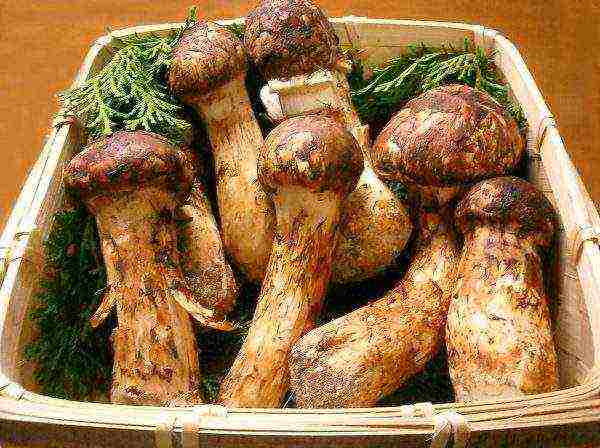
Landing
Porcini mushrooms are propagated in boxes or bags filled with substrate. Experts recommend using exactly boxes with a substrate. Its composition is standard - a mixture of hay, husk of seeds or corn cobs, an admixture of sawdust. This mixture is sterilized and packed into boxes in layers.
The bags or boxes themselves are placed at a distance of 5-6 cm from each other. In the bags, cuts are made for ventilation.
The room temperature should be raised to 25 degrees Celsius, no lighting is required. It is also not worth ventilating the room, but make sure that the humidity is not more than 90%. After germination, the temperature is lowered to 10 heat, and a series of airings is started.
Twice a day, the mycelium is irrigated with warm water. They turn on the lighting for 5-6 hours, in which case the harvest will be ready in 3 weeks. Work on cleaning the premises from debris should become permanent, you need to strive for sterile cleanliness.
Outcome
Growing mushrooms in a basement, cellar, or other artificial environment is relatively risky. Myceliums exist in symbiosis with the root system of trees and without them they may simply not take root. But if it is still possible to master the method of artificial cultivation, then a stable harvest of juicy, tasty and healthy fruits will be provided for several years.

